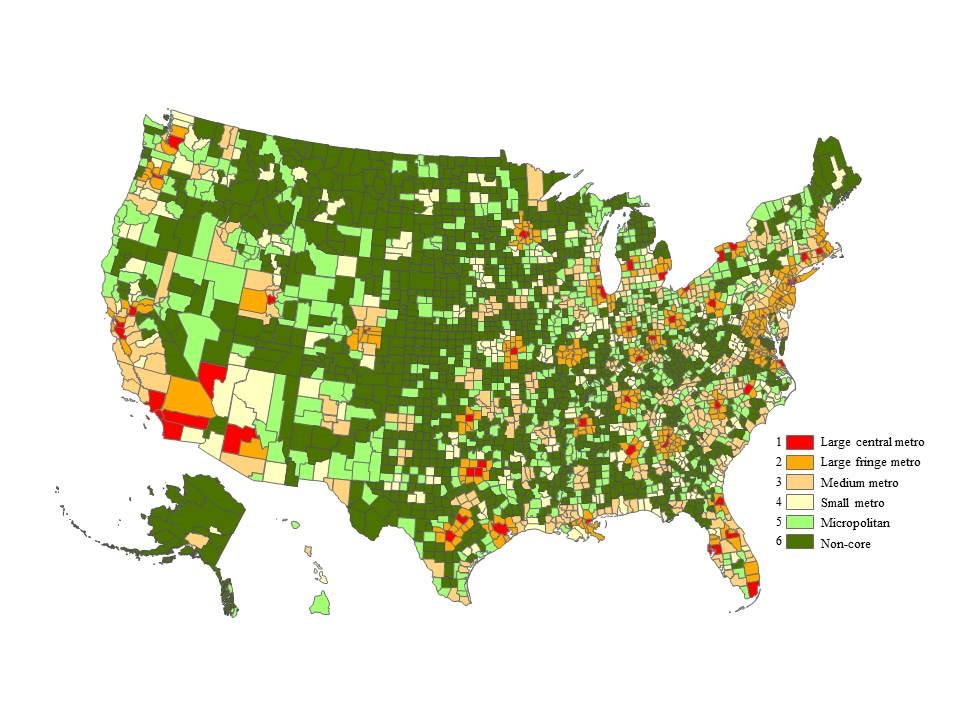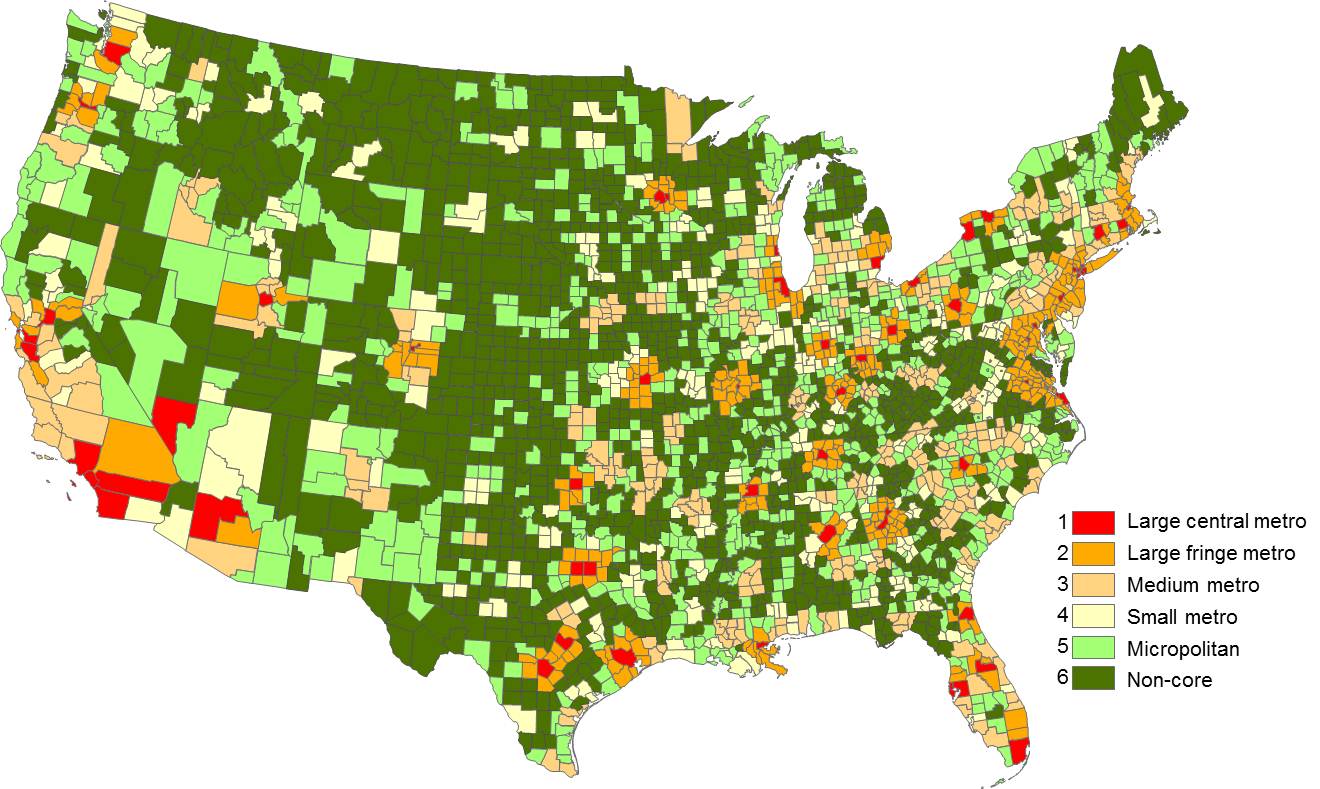At a glance
- The National Center for Health Statistics (NCHS) has developed a system (scheme) for classifying U.S. counties by how urban or rural they are.
- The NCHS Urban-Rural Classification Scheme is particularly useful for health research and health data analysis.

Overview
Announcement
Researchers frequently use National Center for Health Statistics (NCHS) data to study American's health in relation to the urbanization level—more urban or more rural—of the place they live. They can also use NCHS data to monitor the health of people living in urban and rural areas.
NCHS has developed a six-level urban-rural classification scheme for U.S. counties and other jurisdictions (like parishes) that are the equivalent of counties in their area. The most urban category consists of “central” counties of large metropolitan areas and the most rural category consists of nonmetropolitan “noncore” counties.
Urbanization levels
The levels of the NCHS scheme were chosen because they are useful for studying health differences across areas ranging from the most urban to the most rural (the urban-rural continuum). The NCHS scheme has four metropolitan levels and two nonmetropolitan levels because a large portion of the U.S. population lives in metropolitan areas—85% in 2010. That means that metropolitan areas can support more levels for health analyses than the relatively small nonmetropolitan population.
A key feature of the NCHS urban-rural scheme is that it separates counties within large metropolitan areas that have 1 million or more population into two categories:
- Large “central” metro (akin to inner cities)
- Large “fringe” metro (akin to suburbs)
Classifying large metro counties this way makes it particularly well-suited for health analyses. For a number of health measures, residents of large fringe metro areas fare substantially better than residents of other urbanization levels. For these measures, residents of the inner cities and suburbs of large metropolitan areas must be differentiated to obtain an accurate characterization of health disparities.
Schema versions
Three versions of the NCHS Urban-Rural Classification Scheme are available.
2013 NCHS Urban-Rural Classification Scheme for Counties, based on—
- The Office of Management and Budget’s (OMB) February 2013 delineation of metropolitan statistical areas (MSA) and micropolitan statistical areas
- This delineation is derived from the 2010 OMB standards for defining these areas
- This delineation is derived from the 2010 OMB standards for defining these areas
- The Vintage 2012 postcensal estimates of the resident U.S. population
2006 NCHS Urban-Rural Classification Scheme for Counties, based on—
- OMB’s December 2005 delineation of MSAs and micropolitan statistical areas
- This delineation is derived from the 2000 OMB standards for defining these areas
- This delineation is derived from the 2000 OMB standards for defining these areas
- Vintage 2004 postcensal estimates of the resident U.S. population
1990 Census-based NCHS Urban-Rural Classification Scheme for Counties, based on—
- OMB’s June 1993 delineation of MSAs
- This delineation is derived from the 1990 OMB standards for defining these areas
- This delineation is derived from the 1990 OMB standards for defining these areas
- 1990 census data
The basic framework of the three schemes is the same. NCHS used the same classification rules to assign counties to the six urban-rural categories in the 2013 and 2006 schemes. NCHS used somewhat different classification rules for the 1990 census-based scheme.
2013 Urban-Rural Classification Scheme
2013 NCHS Urban–Rural Classification Scheme for Counties details development of the 2013 scheme. It also provides examples of the scheme's application to mortality data and to health measures from the National Health Interview Survey. The report also compares the 2013 and 2006 NCHS schemes.

Metropolitan counties
- Large central metro counties are counties in MSA of 1 million population that—
- Contain the entire population of the largest principal city of the MSA, or
- Are completely contained within the largest principal city of the MSA, or
- Contain at least 250,000 residents of any principal city in the MSA
- Contain the entire population of the largest principal city of the MSA, or
- Large fringe metro counties in MSA of 1 million or more population that do not qualify as large central
- Medium metro counties in MSA of 250,000-999,999 population
- Small metro counties are counties in MSAs of less than 250,000 population
Nonmetropolitan counties
- Micropolitan counties in micropolitan statistical area
- Micropolitan statistical areas are associated with at least one urban cluster of at least 10,000 but less than 50,000 population
- Micropolitan statistical areas also include adjacent counties having a high degree of social and economic integration with the core as measured through commuting ties
- Micropolitan statistical areas are associated with at least one urban cluster of at least 10,000 but less than 50,000 population
- Noncore counties not in micropolitan statistical areas
2006 Urban-Rural Classification Scheme
NCHS Urban–Rural Classification Scheme for Counties details development of the 2006 NCHS scheme. It also provides some examples of the scheme's application to mortality data and to health measures from the National Health Interview Survey. The report also describes the 1990 census-based NCHS scheme.

Metropolitan counties
- Large central metro counties are counties in metropolitan statistical areas of 1 million or more population that—
- Contain the entire population of the largest principal city of the MSA, or
- Are completely contained in the largest principal city of the MSA, or
- Contain at least 250,000 residents of any principal city of the MSA
- Contain the entire population of the largest principal city of the MSA, or
- Large fringe metro counties are counties in MSAs of 1 million or more population that do not qualify as large central
- Medium metro counties are counties in MSAs of 250,000 to 999,999 population.
- Small metro counties are counties in MSAs of less than 250,000 population
Nonmetropolitan counties
- Micropolitan counties are counties in micropolitan statistical areas
- Micropolitan statistical areas are associated with at least one urban cluster of at least 10,000 but less than 50,000 population
- Micropolitan statistical areas also include adjacent counties having a high degree of social and economic integration with the core as measured through commuting ties
- Micropolitan statistical areas are associated with at least one urban cluster of at least 10,000 but less than 50,000 population
- Non-core counties are nonmetropolitan counties that are not in a micropolitan statistical area
Use with natality and mortality files
The NCHS Urban-Rural Classification Scheme for Counties should be used only with data files in which all counties are identified. For 2005–present, the public use mortality files have no geographic detail.
Before 2005, standard mortality and natality public-use files did not identify counties with populations less than 100,000. Specifically, the county FIPS codes for counties with populations less than 100,000 are not provided on these files. Instead, all of these counties are assigned the same geographic code for “balance of state.”
Because there are counties with populations less than 100,000 in all of the urban-rural categories except the large central metro category, it is not possible to compute birth and death rates by urbanization level using these standard natality and mortality public-use files.
Access to mortality and natality files with all counties identified currently requires—
- Project approval by NCHS
- Signing of a data use agreement
Related links
- Bridged-race population estimates
- Compressed Mortality File
- Metropolitan and Micropolitan Areas
- USDA Economic Research Service: Rural-Urban Continuum Codes
- USDA Economic Research Service: Urban Influence Codes
- Health, United States 2001: Urban and Rural Chartbook
- 2014 Update of the Rural-Urban Chartbook
